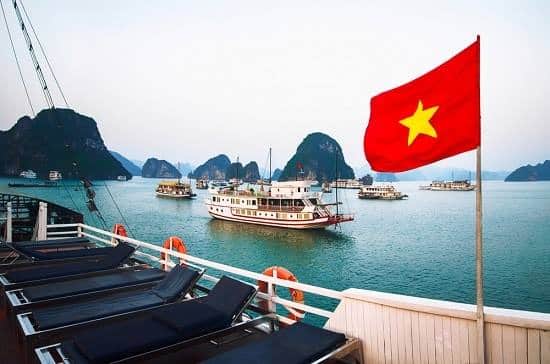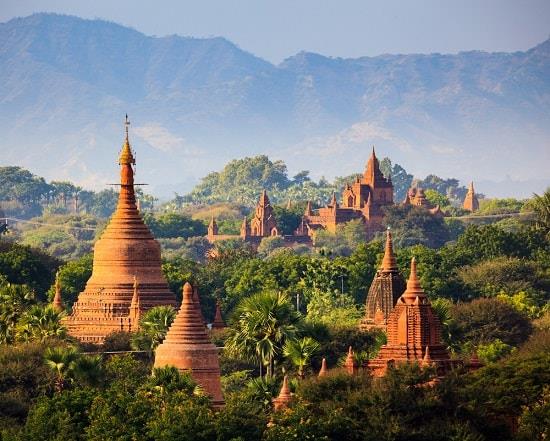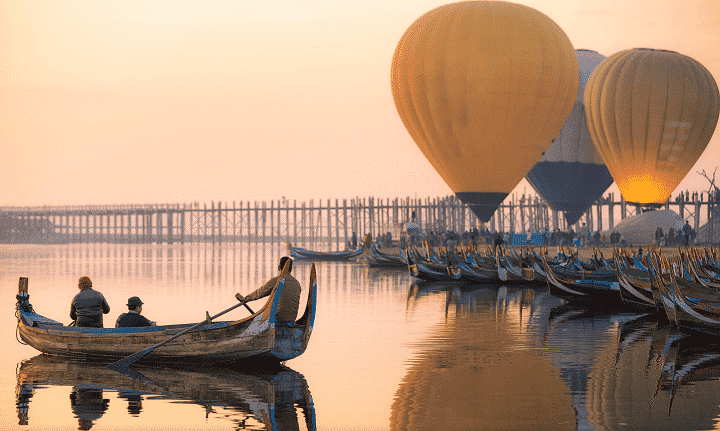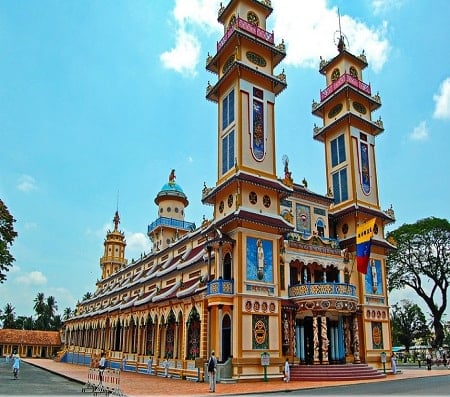10 Best Day Trips from Ho Chi Minh City
Day trips from Ho Chi Minh City (widely known as Saigon), to anywhere in the south of Vietnam, the city is the heart and soul of Vietnam and planning day trips and excursions are just part of what you will have as a joy of traveling to Vietnam. It’s a bustling, dynamic and industrious centre, the largest city in the country, the economic capital and the cultural trendsetter. Yet within the teeming metropolis are the timeless traditions and beauty of an ancient culture. This is a city that churns, ferments, bubbles and fumes. The streets, where much of the city’s life takes place, are a jumble of street markets, shops, pavement cafes, stands-on-wheels and vendors selling wares spread out on sidewalks. It’s impossible not to be infected by its exhilarating vibe.
The best time to visit Ho Chi Minh City, weather-wise is the dry season between December and April, when the humidity is more manageable. The crowds start getting heavy around November and stay through March. The Tet Festival in late January or early February is an exciting, if extremely hectic, time to visit. Being only 10.5° above the equator and between 5 and 10m (16-35ft) above sea level, Ho Chi Minh City is almost a template for tropical weather. Temperatures rarely vary from about 30°C (86°F); however, the seven- or eight-month wet season can certainly make things wet, sweaty and generally uncomfortable. Heavy downpours can last for days on end, although the city is largely spared the devastation of typhoons that hit the northern areas of the country. The driest time is between December and April, when the humidity is mercifully down below 60%. Anyway, this is Saigon and is still loved by millions of travelers and expats.
1. Mekong Delta
Adventure day trips from Ho Chi Minh city to Mekong Delta, here is Vietnam’s ‘rice basket’, the Mekong Delta is a watery landscape of green fields and sleepy villages, everywhere crisscrossed by the brown canals and rivulets fed by the mighty Mekong River. And, in fact, it is one of the very popular day trip and overnight stay options from Ho Chi Minh City. Its inhabitants – stereotyped as friendly and easygoing – have long toiled on the life-sustaining river, with their labours marked by the same cycles governing the waterways. The delta, which yields enough rice to feed the country with a sizable surplus, was formed by sediment deposited by the Mekong. The process continues today, with silt deposits extending the shoreline by as much as 80m per year. The river is so large that it has two daily tides. Lush with rice paddies and fish farms, this delta plain also nourishes the cultivation of sugarcane, fruit, coconut and shrimp. Although the area is primarily rural, it is one of the most densely populated regions in Vietnam and nearly every hectare is intensively farmed.
My Tho, the quiet capital city of Tien Giang province, is the traditional gateway to the Mekong delta, owing to its proximity to HCMC. Visitors on a whirlwind Vietnam tour often take a day trip here to catch a glimpse of the famous river. In order to visit floating markets, however, you’ll need to continue on to Can Tho. The town itself is an important market town, and its quaint but busy waterfront is easily explored on foot. My Tho was founded in the 1680s by Chinese refugees fleeing Taiwan for political reasons. The Chinese have virtually all gone now, having been driven out in the late 1970s when their property was seized by the government. The economy is based on tourism, fishing and the cultivation of rice, coconuts, bananas, mangoes, longans and citrus fruit. Click here to learn more about Fruits in Vietnam you must try.
| Book best Holiday Package deals for travel within Thailand in 2024. Save on luxury hotels + private holiday options. Grab an exclusive Tour packages in Thailand |
2. Cu Chi Tunnels
The town of Cu Chi is a district of greater HCMC and has a population of about 200, 000 (it had about 80, 000 residents during the American War). At first glance there is little evidence here to indicate the intense fighting, bombing and destruction that occurred in Cu Chi during the war. To see what went on, you have to dig deeper – underground. The tunnel network of Cu Chi became legendary during the 1960s for its role in facilitating Viet Cong (VC) control of a large rural area only 30km to 40km from HCMC. At its height the tunnel system stretched from the South Vietnamese capital to the Cambodian border; in the district of Cu Chi alone there were more than 250km of tunnels. The network, parts of which was several storeys deep, included innumerable trap doors, constructed living areas, storage facilities, weapons factories, field hospitals, command centres and kitchens.
Getting there & around Cu Chi
Cu Chi district covers a large area, parts of which are as close as 30km to central HCMC. The Cu Chi War History Museum is closest to the city, while the Ben Dinh and Ben Duoc tunnels are about 50km and 70km, respectively, from central HCMC by highway. There’s a back road that reduces the distance significantly, though it means driving on bumpy dirt roads. Hiring a taxi in HCMC and driving out to Cu Chi is not all that expensive, especially if the cost is shared by several people. The easiest way to do this is to stop by one of the budget travel cafés in Pham Ngu Lao and arrange a car, or see if you can flag a taxi in that neighbourhood with a driver who will agree to charge you for driving time only. A visit to the Cu Chi tunnel complex can easily be combined with a stop at the headquarters of the Cao Dai sect in Tay Ninh. A taxi for an all-day excursion to both should cost about US$45. The buses going to Tay Ninh pass though Cu Chi, but getting from the town of Cu Chi to the tunnels by public transport is impossible – it’s 15km, so you’ll have to hire a motorbike from Tay Ninh (around US$6 return).
3. Cao Dai Temple in Tay Ninh
Cao Dai temple in Tay Ninh town, the capital of Tay Ninh province, serves as the headquarters of one of Vietnam’s most interesting indigenous religions, Cao Daism. The Cao Dai Great Temple at the sect’s Holy See is one of the most striking structures in all of Asia. Built between 1933 and 1955, the temple is a rococo extravaganza combining the conflicting architectural idiosyncrasies of a French church, a Chinese pagoda, Hong Kong’s Tiger Balm Gardens and Madame Tussaud’s Wax Museum. Tay Ninh province, northwest of HCMC, is bordered by Cambodia on three sides. The area’s dominant geographic feature is Nui Ba Den (Black Lady Mountain), which towers above the surrounding plains. Tay Ninh province’s eastern border is formed by the Saigon River. The Vam Co River flows from Cambodia through the western part of the province.
Tay Ninh is on Hwy 22 (Quoc Lo 22), 96km from HCMC. (The road passes through Trang Bang, the place where the famous photograph of a severely burnt young girl, screaming and running, was taken by a journalist during a US napalm attack) There are several Cao Dai temples along Hwy 22, including one (which was under construction in 1975) that was heavily damaged by the VC. An easy way to get to Tay Ninh is by chartered taxi, perhaps on a day trip that includes a stop in Cu Chi. An all-day return trip from HCMC to both should cost about US$45. There are buses from HCMC to Tay Ninh that leave from the Tay Ninh bus station (Ben Xe Tay Ninh) in Tan Binh district and Mien Tay bus station in An Lac.
4. Nui Ba Den; Black Virgin Mountain
Fifteen kilometres northeast of Tay Ninh, Nui Ba Den (Black Lady Mountain; admission adult/child 8000/4000d) rises 850m above the rice paddies, corn, cassava (manioc) and rubber plantations of the surrounding countryside. Over the centuries Nui Ba Den has served as a shrine for various peoples of the area, including the Khmer, Chams, Vietnamese and Chinese, and there are several interesting cave temples on the mountain. The summits of Nui Ba Den are much cooler than the rest of Tay Ninh province, most of which is only a few dozen metres above sea level. Nui Ba Den was used as a staging area by both the Viet Minh and the VC, and was the scene of fierce fighting during the French and American Wars. At one time there was a US Army firebase and relay station at the summit, which was later, ironically, defoliated and heavily bombed by US aircraft. Because of Ba Den mountain’s popularity by locals and tourists, we advice to visit during the weekdays.
To get to the black virgin mountain from Ho Chi Minh City, you first need tp get to Tay Nihn, then change to Nui Den area. Taxis, Grab and tours are the options.
5. Vinh Long, Cai Be & Can Tho Floating Market
A bit more chaotic than other Mekong towns of its size, Vinh Long has noisy, motorbike-filled streets, though its riverfront (and its several restaurants) make for a pleasant escape from the mayhem. Despite the lack of in-town attractions, Vinh Long is the gateway to river islands and some worthwhile sites, including the Cai Be floating market, orchards and homestays – which can be a highlight of a Mekong journey. Vinh Long is the capital of Vinh Long province and situated about midway between My Tho and Can Tho.
The largest city in the Mekong, Can Tho is a buzzing town with a lively waterfront and a colourful mix of narrow back streets and wide boulevards that make for some rewarding exploration – especially after a few days spent in the wilds. As the political, economic, cultural and transportation centre of the Mekong Delta, Can Tho hums with activity; while its access to nearby floating markets make it a major draw for tourists, who come here to boat along the myriad canals and rivers leading out of town.
Frequent buses go between Vinh Long and HCMC (three hours), which leave HCMC from Cholon bus station in District 5, and from Mien Tay bus station. You can also get to Vinh Long by bus from Can Tho , My Tho, Tra Vinh, Chau Doc and other points on the Mekong Delta. Vinh Long’s bus station is conveniently located smack bang in the middle of town. Vinh Long is just off Hwy 1, 66km from My Tho, 33km from Can Tho and 136km from HCMC. For Can Tho, There are buses leaving HCMC from Mien Tay bus station (five hours). Express minibuses make the same trip in about the same time. The main bus station in Can Tho is about a kilometre north of town at the intersection of Ð Nguyen Trai and Ð Tran Phu. There is another short-haul bus depot about 300m south of the intersection of Ð 30 Thang 4 and Ð Mau Than, which is good for getting to Soc Trang and the Phung Hiep floating market.

6. Vũng Tàu
Popular beach escape as a day trip from Saigon. Vung Tau drones with bass-thumping action on the weekends as visitors from HCMC motor into town; weekdays, however, are blissfully dead. Vung Tau’s beaches are easily reached from HCMC, making them a favourite of that city’s residents since French colonists first began coming here around 1890. Known under the French as Cap St Jacques – so-named by Portuguese mariners in honour of their patron saint – Vung Tau is a commercialised beach resort on a peninsula jutting into the South China Sea, about 128km southeast of HCMC (via Bien Hoa). The business of oil-drilling here means the azure horizon is marred by frequent oil tankers, and the population flecked with joy-seeking expats.
From Mien Dong bus station in HCMC, air-con minibuses (25, 000d, two hours, 128km) leave for Vung Tau throughout the day until around 4.30pm. From Vung Tau’s bus station (192A Ð Nam Ky Khoi Nghia) to Mulberry Beach or Back Beach, a xe om should cost around 10, 000d. Should convenience outweigh cost, catch a Petro Express hydrofoil (HCMC 08-821 0650, Vung Tau 816 308) to Vung Tau (120, 000d, 90 minutes) at Bach Dang jetty in HCMC. Boats leave roughly two hours starting at 6.30am, but check in HCMC for the latest schedule. In Vung Tau the boat leaves from Cau Da pier, opposite the Hai Au Hotel.

7. Ho Coc Beach
Another weekend getaway and a very popular day trips from Ho Chi Minh City, keep heading along the coastal road, another 12km or so from Ho Tram, and you’ll arrive at the remote and beautiful Ho Coc Beach. Golden sands backed by dunes and clear waters, along with the lack of development, make it a draw – particularly on weekdays, when you’ll have the beach largely to yourself. As elsewhere along the coast, weekends bring crowds of Vietnamese tourists. The area around the beach is part of an 11, 000-hectare rainforest that was designated a nature reserve in 1975. Most of the larger wildlife was exterminated or else relocated for safety reasons (most of the elephants were sent to Thailand), but plenty of birds and monkeys can be spotted in the forest. Guides for the walking trails can be hired for about 50, 000d a day. Inquire at Hang Duong Ho Coc.
There’s no public transport out here, but some of the budget cafés in HCMC offer appealing day and overnight trips to Ho Coc. Saigon Tourist (08-829 8914; www.saigontourist.net; 49 Ð Le Thanh Ton, HCMC) puts together trips to Ho Coc that include a visit to Binh Chau Hot Springs Resort. This also makes for a good (but very long) day trip on a motorbike – which you can also hire in Vung Tau. The new road is in decent shape, and it’s a particularly magical ride past sand dunes with lovely ocean views on certain stretches of the road between Ho Tram and Ho Coc.
8. Cần Giờ Biosphere Reserve
Notable for its mangrove forest, Can Gio is a low palm-fringed island some 25km southeast of HCMC. The island, which is at the intersection between the Saigon River and the sea, was created by silt washing downstream. It’s hard-packed mud rather than sandy beach, so attracts few visitors and the area remains entirely undeveloped. The principal attraction here – and it’s a minor one – is Can Gio mangrove forest (Lam Vien Can Gio; 874 3069; fax 874 3068; admission 15, 000d). Formed by sediment deposits from the Dong Nai and Long Tau Rivers, this forest sounds impressive on paper: its 75, 000 hectares contains a high degree of biodiversity with more than 200 species of fauna and 50 species of flora. Infrastructure, however, is lacking, and only mangrove enthusiasts will truly enjoy the trip out. There is also the Can Gio Museum, which has displays on the wildlife of the forest, along with exhibits relating to local war history; the park also has a monkey sanctuary, home to at least a hundred simians. Admission to the Can Gio mangrove forest also covers the museum.
Can Gio is about 60km southeast of central HCMC, and the fastest way to make the journey is by car or motorbike (about two hours). There’s a ferry crossing (motorbike/car 2000/10, 000d) 15km from HCMC at Binh Khanh (Cat Lai), a former US naval base. The road is paved all the way from HCMC to Can Gio. Once you get past the ferry, there is little traffic and the sides of the road are lined with mangrove forests.
9. Tan Lap Floating Village
Considering a day trip Tan to Lap Floating Village from Ho Chi Minh City and find yourself in an ecotourism area filled with scenic beauty. The area is inhabitant and it is only open to visitors, once in the floating village, take a boat trip to cross the magical water-lilies and enjoy the quite atmosphere. What to visit on Tan Lap floating village? If you love photography and appreciate the ecotourism, this is a place to be from Saigon. To get to the area, you need an admission tiket of 50,000 VND which is actually a pass to boat trip, the boat-man will lead the boat and guide you through the floating village.
Getting there & away: From central Saigon, take a public transport from Cholon Station and or from Long An, with the trip taking almost 4 hours. If you are driving your own vehicle and or going by motorbike, then, the way is more pleasant and it takes only 2 hours.
10. Cat Tien National Park
One of the outstanding gems of the region, the 72, 000-hectare Cat Tien National Park comprises an amazingly biodiverse region of lowland tropical rain forest. The hiking, mountain biking and bird-watching are easily the best in Southern Vietnam. Always call ahead for reservations as the park can accommodate only a limited number of visitors. In the 2nd century AD the Cat Tien area was a religious centre of the Funan empire, and ancient Oc-Eo cultural relics have been discovered in the park. Cat Tien was hit hard by defoliants during the American War, but the large old-growth trees survived and the smaller plants have recovered. Just as importantly, the wildlife has made a comeback and in 2001 Unesco added Cat Tien National Park to its list of biosphere reserves. Since then, infrastructure has improved markedly with decent overnight options. It’s worth spending at least two full days here, if possible.
Whichever way you come, you’ll be dropped off at the park office, 100m before the ferry across the Dong Nai River to park headquarters. Buy your entrance ticket from the park office, which will include the price of the ferry crossing. The most common approach to the park is from Hwy 20, which connects Dalat with HCMC. To reach the park, follow the narrow 24km road, which branches west from Hwy 20 at Talai Junction (Nga Ban Talai), 125km north of HCMC and 175km south of Dalat. The road to the park is signposted at the junction, and with your own wheels getting there shouldn’t be a hassle. By bus, take any Dalat-bound service (35, 000d, four hours) and tell the driver to let you off at Vuon Quoc Gia Cat Tien. From this junction, you can hire a motorbike (they’re always around) to take you the remaining 25km to the park (around 40, 000d).
Day trips from Ho Chi Minh City to Cambodia: How long does it take from Ho Chi Minh City to Cambodia? To answer such a questions and even more, there are frequent daily bused departing Ho Chi Minh City/Saigon to Phnom Penh city, Capital of Cambodia. Traveling time excluding the border and check-point formalities takes something between 6 to 8 hours. Many tourist consider a day trip to Cambodia from Saigon as part of the visa run, so, if you do the same, think about it as there are pretty much a lot of things to discover in Cambodia.Ho Chi Minh City is the heart and soul of Vietnam. It’s a bustling, dynamic and industrious centre, the largest city in the country, the economic capital and the cultural trendsetter. Yet within the teeming metropolis are the timeless traditions and beauty of an ancient culture. This is a city that churns, ferments, bubbles and fumes. The streets, where much of the city’s life takes place, are a jumble of street markets, shops, pavement cafes, stands-on-wheels and vendors selling wares spread out on sidewalks. It’s impossible not to be infected by its exhilarating vibe.
Copyright 2013-2017 Vietnamese Private Tours Ltd With Vietnam Luxury Travel








